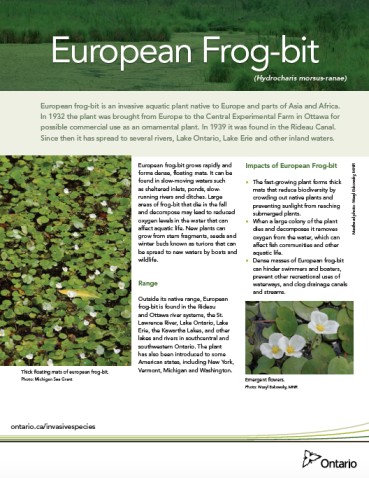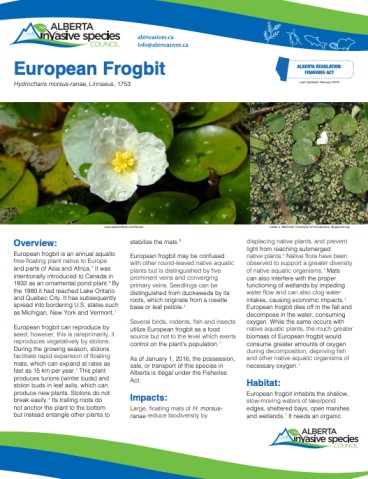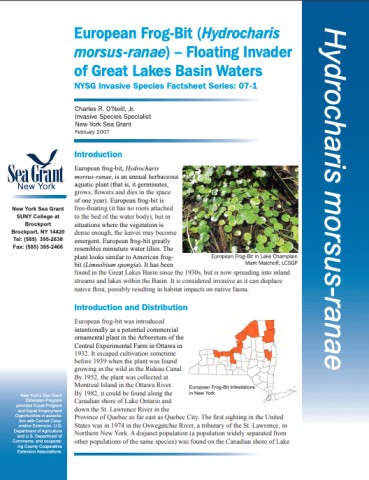European Frog-bit (Hydrocharis morsus-ranae)
French common name: Hydrocharide grenouillette
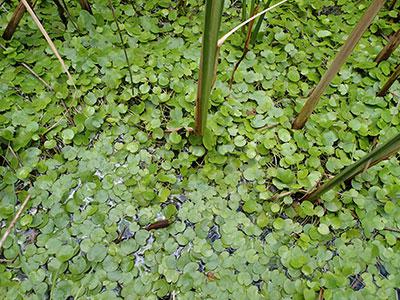
European frog-bit infestation
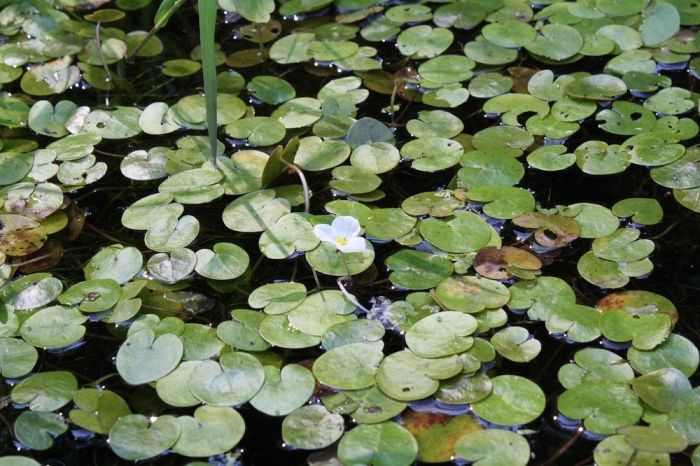
European frog-bit
Photo by Meghan Johnstone
Order: Alismatales
Family: Hydrocharitaceae
Did you know? European frog-bit can be free floating or send down roots in shallow waters.
European frog-bit resembles native water lilies, but it has smaller, floating, heart-shaped leaves (2-5 cm) and the small (2 cm) white flower has three petals and a yellow centre. Flowers are emergent (above water surface). European frog-bit can be free floating or root in shallow water. This invasive plant forms large, dense floating mats of intertwining plants that may compete with native submerged plants for light and nutrients. As these large mats of vegetation die, they deoxygenate the water, which harms native fish and aquatic species. New plants can grow from stem fragments which makes it very easily spread by boat disturbance.
European frog-bit is a free-floating aquatic plant with leathery, heart-shaped leaves and small white flowers with three petals. The root system is well developed, but does not normally anchor the plant to the substrate (Environment Canada, 2003).
European frog-bit grows rapidly and forms dense, floating mats. It can be found in slow-moving waters such as sheltered inlets, ponds, slow-running rivers, and ditches. Large areas of frog-bit that die in the fall and decompose may lead to reduced oxygen levels in the water that can affect aquatic life. New plants can grow from stem fragments, seeds and winter buds (known as turions) that can be spread to new waters by boats and wildlife (Ontario, 2018).
- The plant can float free or put down roots up to 50 cm long in shallow water.
- It produces a single white flower up to two cm wide with three rounded petals and a yellow centre.
- Leaves are 2.5-5 cm wide (about the size of a Canadian loonie) and round/heart-shaped. They form a rosette up to 6 cm wide.
- The leaf bottom is purple-red with a spongy coating along the middle vein of the leaf that allows it to float on the water.
In 1932, this plant was brought over from Europe to the Central Experimental Farm in Ottawa, Ontario, as a potential ornamental plant, where it escaped into the Rideau Canal by 1939.
Outside its native range, European frog-bit is found in the Rideau and Ottawa river systems, the St. Lawrence River, Lake Ontario, Lake Erie, the Kawartha Lakes, Lake Huron along St. Joesph’s Island, and other lakes and rivers in southcentral and southwestern Ontario. The plant has also been introduced to some American states, including New York, Vermont, Michigan, and Washington (Ontario, 2016).

(Range map provided courtesy of the USDA website and is displayed here in accordance with their policies)
The free-floating form of this plant can lead to densely-tangled floating mats, which can crowd and shade out native aquatic vegetation. It can dominate wetlands where it occurs, and the dense mats may affect wildlife as well as native plants (Environment Canada 2003).
European frog-bit grows rapidly and can be found in slow-moving waters such as sheltered inlets, ponds, slow-running rivers, and ditches. Large areas of frog-bit that die in the fall and decompose may lead to reduced oxygen levels in the water that can affect aquatic life. New plants can grow from stem fragments, seeds and winter buds (known as turions) that can be spread to new waters by boats and wildlife (Ontario, 2016)
Learn how to identify European frog-bit and prevent accidentally spreading this plant with your watercraft.
- Avoid infested areas or reduce your speed when travelling near European frog-bit. Boat wake can dislodge plants and allow them to spread to new areas.
- Inspect your boat, trailer, and equipment after each use. Remove all plants, animals, and mud before moving to a new waterbody.
- Avoid planting European frog-bit in your aquarium or water garden. Aquarium hobbyists and water gardeners should only use native or non-invasive plants. Ask your retailer for advice on plants that are not invasive.
- Never release unwanted aquarium plants or pets. Return or donate unwanted plants to a garden centre or pet store, or put them in the garbage.
- If you’ve seen European frog-bit or another invasive species in the wild, please contact the toll-free Invading Species Hotline at 1-800-563-7711, or visit www.invadingspecies.com to report a sighting (Ontario, 2016).
Fact Sheets
Research
[PDF] European Frogbit Management and its Impact of Native Zooplankton Abundance and Diversity
First introduced to Canada in 1932, it has since spread southward into the Finger Lakes
region. Its presence can have detrimental effects on the biological community as well as …
[HTML] Shading as a control method for invasive European frogbit (Hydrocharis morsus-ranae L.)
economic impacts in North American water bodies. It is therefore important to develop
effective management tools to control this invasive species. This study investigated shading …
Effects of invasive European frogbit and its two physical control methods on macroinvertebrates
affects native plants in freshwater ecosystems. We conducted a field mesocosm experiment
in Oneida Lake, New York (USA), to study the effect of frogbit cover on macroinvertebrates …
[PDF] Investigating snails as potential biological control agents for invasive European frogbit (Hydrocharis morsus-ranae)
and invasive species that have altered ecosystem functions (Mills et al. 1994, Ricciardi
2001, Zhu et al. 2006, 2007). A floating aquatic plant—European frogbit (also called …
Further Reading
The Invasive Species Centre aims to connect stakeholders. The following information below link to resources that have been created by external organizations.

